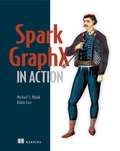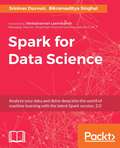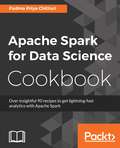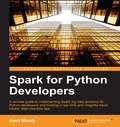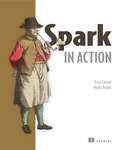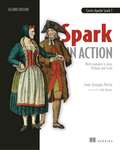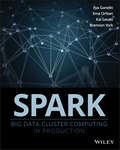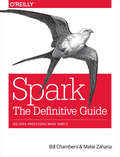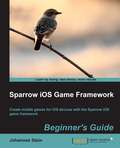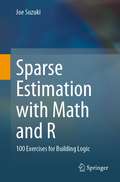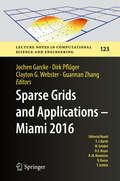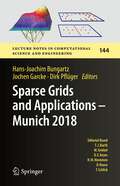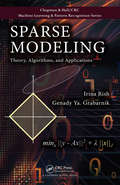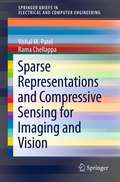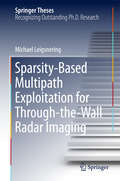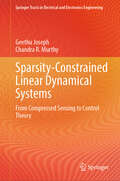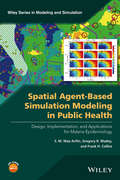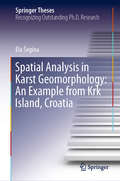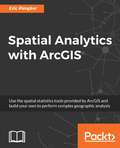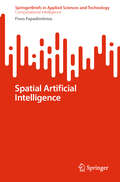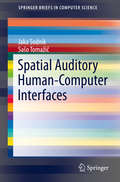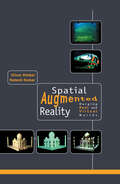- Table View
- List View
Spark GraphX in Action
by Michael Malak Robin EastSummarySpark GraphX in Action starts out with an overview of Apache Spark and the GraphX graph processing API. This example-based tutorial then teaches you how to configure GraphX and how to use it interactively. Along the way, you'll collect practical techniques for enhancing applications and applying machine learning algorithms to graph data.Purchase of the print book includes a free eBook in PDF, Kindle, and ePub formats from Manning Publications.About the TechnologyGraphX is a powerful graph processing API for the Apache Spark analytics engine that lets you draw insights from large datasets. GraphX gives you unprecedented speed and capacity for running massively parallel and machine learning algorithms.About the BookSpark GraphX in Action begins with the big picture of what graphs can be used for. This example-based tutorial teaches you how to use GraphX interactively. You'll start with a crystal-clear introduction to building big data graphs from regular data, and then explore the problems and possibilities of implementing graph algorithms and architecting graph processing pipelines. Along the way, you'll collect practical techniques for enhancing applications and applying machine learning algorithms to graph data.What's InsideUnderstanding graph technologyUsing the GraphX APIDeveloping algorithms for big graphsMachine learning with graphsGraph visualizationAbout the ReaderReaders should be comfortable writing code. Experience with Apache Spark and Scala is not required.About the AuthorsMichael Malak has worked on Spark applications for Fortune 500 companies since early 2013. Robin East has worked as a consultant to large organizations for over 15 years and is a data scientist at Worldpay.Table of ContentsPART 1 SPARK AND GRAPHSTwo important technologies: Spark and graphsGraphX quick startSome fundamentalsPART 2 CONNECTING VERTICESGraphX BasicsBuilt-in algorithmsOther useful graph algorithmsMachine learningPART 3 OVER THE ARCThe missing algorithmsPerformance and monitoringOther languages and tools
Spark for Data Science
by Srinivas Duvvuri Bikramaditya SinghalAnalyze your data and delve deep into the world of machine learning with the latest Spark version, 2.0 About This Book * Perform data analysis and build predictive models on huge datasets that leverage Apache Spark * Learn to integrate data science algorithms and techniques with the fast and scalable computing features of Spark to address big data challenges * Work through practical examples on real-world problems with sample code snippets Who This Book Is For This book is for anyone who wants to leverage Apache Spark for data science and machine learning. If you are a technologist who wants to expand your knowledge to perform data science operations in Spark, or a data scientist who wants to understand how algorithms are implemented in Spark, or a newbie with minimal development experience who wants to learn about Big Data Analytics, this book is for you! What You Will Learn * Consolidate, clean, and transform your data acquired from various data sources * Perform statistical analysis of data to find hidden insights * Explore graphical techniques to see what your data looks like * Use machine learning techniques to build predictive models * Build scalable data products and solutions * Start programming using the RDD, DataFrame and Dataset APIs * Become an expert by improving your data analytical skills In Detail This is the era of Big Data. The words 'Big Data' implies big innovation and enables a competitive advantage for businesses. Apache Spark was designed to perform Big Data analytics at scale, and so Spark is equipped with the necessary algorithms and supports multiple programming languages. Whether you are a technologist, a data scientist, or a beginner to Big Data analytics, this book will provide you with all the skills necessary to perform statistical data analysis, data visualization, predictive modeling, and build scalable data products or solutions using Python, Scala, and R. With ample case studies and real-world examples, Spark for Data Science will help you ensure the successful execution of your data science projects. Style and approach This book takes a step-by-step approach to statistical analysis and machine learning, and is explained in a conversational and easy-to-follow style. Each topic is explained sequentially with a focus on the fundamentals as well as the advanced concepts of algorithms and techniques. Real-world examples with sample code snippets are also included.
Spark for Data Science Cookbook
by Padma Priya ChitturiThis book is for novice and intermediate level data scientists and data analysts who want to solve data science problems using a distributed computing framework such as Spark. You are expected to have knowledge on statistics, data science tools such as R and Pandas, and an understanding of distributed systems, as well as some exposure to Hadoop.
Spark for Python Developers
by Amit NandiA concise guide to implementing Spark Big Data analytics for Python developers, and building a real-time and insightful trend tracker data intensive app About This Book * Set up real-time streaming and batch data intensive infrastructure using Spark and Python * Deliver insightful visualizations in a web app using Spark (PySpark) * Inject live data using Spark Streaming with real-time events Who This Book Is For This book is for data scientists and software developers with a focus on Python who want to work with the Spark engine, and it will also benefit Enterprise Architects. All you need to have is a good background of Python and an inclination to work with Spark. What You Will Learn * Create a Python development environment powered by Spark (PySpark), Blaze, and Bookeh * Build a real-time trend tracker data intensive app * Visualize the trends and insights gained from data using Bookeh * Generate insights from data using machine learning through Spark MLLIB * Juggle with data using Blaze * Create training data sets and train the Machine Learning models * Test the machine learning models on test datasets * Deploy the machine learning algorithms and models and scale it for real-time events In Detail Looking for a cluster computing system that provides high-level APIs? Apache Spark is your answer--an open source, fast, and general purpose cluster computing system. Spark's multi-stage memory primitives provide performance up to 100 times faster than Hadoop, and it is also well-suited for machine learning algorithms. Are you a Python developer inclined to work with Spark engine? If so, this book will be your companion as you create data-intensive app using Spark as a processing engine, Python visualization libraries, and web frameworks such as Flask. To begin with, you will learn the most effective way to install the Python development environment powered by Spark, Blaze, and Bookeh. You will then find out how to connect with data stores such as MySQL, MongoDB, Cassandra, and Hadoop. You'll expand your skills throughout, getting familiarized with the various data sources (Github, Twitter, Meetup, and Blogs), their data structures, and solutions to effectively tackle complexities. You'll explore datasets using iPython Notebook and will discover how to optimize the data models and pipeline. Finally, you'll get to know how to create training datasets and train the machine learning models. By the end of the book, you will have created a real-time and insightful trend tracker data-intensive app with Spark. Style and approach This is a comprehensive guide packed with easy-to-follow examples that will take your skills to the next level and will get you up and running with Spark.
Spark in Action
by Marko Bonaci Petar ZecevicSummarySpark in Action teaches you the theory and skills you need to effectively handle batch and streaming data using Spark. Fully updated for Spark 2.0.Purchase of the print book includes a free eBook in PDF, Kindle, and ePub formats from Manning Publications.About the TechnologyBig data systems distribute datasets across clusters of machines, making it a challenge to efficiently query, stream, and interpret them. Spark can help. It is a processing system designed specifically for distributed data. It provides easy-to-use interfaces, along with the performance you need for production-quality analytics and machine learning. Spark 2 also adds improved programming APIs, better performance, and countless other upgrades.About the BookSpark in Action teaches you the theory and skills you need to effectively handle batch and streaming data using Spark. You'll get comfortable with the Spark CLI as you work through a few introductory examples. Then, you'll start programming Spark using its core APIs. Along the way, you'll work with structured data using Spark SQL, process near-real-time streaming data, apply machine learning algorithms, and munge graph data using Spark GraphX. For a zero-effort startup, you can download the preconfigured virtual machine ready for you to try the book's code. What's InsideUpdated for Spark 2.0Real-life case studiesSpark DevOps with DockerExamples in Scala, and online in Java and PythonAbout the ReaderWritten for experienced programmers with some background in big data or machine learning. About the AuthorsPetar Zečević and Marko Bonaći are seasoned developers heavily involved in the Spark community.Table of ContentsPART 1 - FIRST STEPSIntroduction to Apache Spark Spark fundamentals Writing Spark applicationsThe Spark API in depth PART 2 - MEET THE SPARK FAMILY Sparkling queries with Spark SQL Ingesting data with Spark Streaming Getting smart with MLlib ML: classification and clustering Connecting the dots with GraphX PART 3 - SPARK OPSRunning Spark Running on a Spark standalone cluster Running on YARN and MesosPART 4 - BRINGING IT TOGETHERCase study: real-time dashboard Deep learning on Spark with H2O
Spark in Action: Covers Apache Spark 3 with Examples in Java, Python, and Scala
by Jean-Georges PerrinSummary The Spark distributed data processing platform provides an easy-to-implement tool for ingesting, streaming, and processing data from any source. In Spark in Action, Second Edition, you&’ll learn to take advantage of Spark&’s core features and incredible processing speed, with applications including real-time computation, delayed evaluation, and machine learning. Spark skills are a hot commodity in enterprises worldwide, and with Spark&’s powerful and flexible Java APIs, you can reap all the benefits without first learning Scala or Hadoop. Purchase of the print book includes a free eBook in PDF, Kindle, and ePub formats from Manning Publications. About the technology Analyzing enterprise data starts by reading, filtering, and merging files and streams from many sources. The Spark data processing engine handles this varied volume like a champ, delivering speeds 100 times faster than Hadoop systems. Thanks to SQL support, an intuitive interface, and a straightforward multilanguage API, you can use Spark without learning a complex new ecosystem. About the book Spark in Action, Second Edition, teaches you to create end-to-end analytics applications. In this entirely new book, you&’ll learn from interesting Java-based examples, including a complete data pipeline for processing NASA satellite data. And you&’ll discover Java, Python, and Scala code samples hosted on GitHub that you can explore and adapt, plus appendixes that give you a cheat sheet for installing tools and understanding Spark-specific terms. What's inside Writing Spark applications in Java Spark application architecture Ingestion through files, databases, streaming, and Elasticsearch Querying distributed datasets with Spark SQL About the reader This book does not assume previous experience with Spark, Scala, or Hadoop. About the author Jean-Georges Perrin is an experienced data and software architect. He is France&’s first IBM Champion and has been honored for 12 consecutive years. Table of Contents PART 1 - THE THEORY CRIPPLED BY AWESOME EXAMPLES 1 So, what is Spark, anyway? 2 Architecture and flow 3 The majestic role of the dataframe 4 Fundamentally lazy 5 Building a simple app for deployment 6 Deploying your simple app PART 2 - INGESTION 7 Ingestion from files 8 Ingestion from databases 9 Advanced ingestion: finding data sources and building your own 10 Ingestion through structured streaming PART 3 - TRANSFORMING YOUR DATA 11 Working with SQL 12 Transforming your data 13 Transforming entire documents 14 Extending transformations with user-defined functions 15 Aggregating your data PART 4 - GOING FURTHER 16 Cache and checkpoint: Enhancing Spark&’s performances 17 Exporting data and building full data pipelines 18 Exploring deployment
Spark: Big Data Cluster Computing in Production
by Ilya Ganelin Ema Orhian Kai Sasaki Brennon YorkProduction-targeted Spark guidance with real-world use cases Spark: Big Data Cluster Computing in Production goes beyond general Spark overviews to provide targeted guidance toward using lightning-fast big-data clustering in production. Written by an expert team well-known in the big data community, this book walks you through the challenges in moving from proof-of-concept or demo Spark applications to live Spark in production. Real use cases provide deep insight into common problems, limitations, challenges, and opportunities, while expert tips and tricks help you get the most out of Spark performance. Coverage includes Spark SQL, Tachyon, Kerberos, ML Lib, YARN, and Mesos, with clear, actionable guidance on resource scheduling, db connectors, streaming, security, and much more. Spark has become the tool of choice for many Big Data problems, with more active contributors than any other Apache Software project. General introductory books abound, but this book is the first to provide deep insight and real-world advice on using Spark in production. Specific guidance, expert tips, and invaluable foresight make this guide an incredibly useful resource for real production settings. Review Spark hardware requirements and estimate cluster size Gain insight from real-world production use cases Tighten security, schedule resources, and fine-tune performance Overcome common problems encountered using Spark in production Spark works with other big data tools including MapReduce and Hadoop, and uses languages you already know like Java, Scala, Python, and R. Lightning speed makes Spark too good to pass up, but understanding limitations and challenges in advance goes a long way toward easing actual production implementation. Spark: Big Data Cluster Computing in Production tells you everything you need to know, with real-world production insight and expert guidance, tips, and tricks.
Spark: Big Data Processing Made Simple
by Matei Zaharia Bill ChambersLearn how to use, deploy, and maintain Apache Spark with this comprehensive guide, written by the creators of the open-source cluster-computing framework. With an emphasis on improvements and new features in Spark 2.0, authors Bill Chambers and Matei Zaharia break down Spark topics into distinct sections, each with unique goals.Youâ??ll explore the basic operations and common functions of Sparkâ??s structured APIs, as well as Structured Streaming, a new high-level API for building end-to-end streaming applications. Developers and system administrators will learn the fundamentals of monitoring, tuning, and debugging Spark, and explore machine learning techniques and scenarios for employing MLlib, Sparkâ??s scalable machine-learning library.Get a gentle overview of big data and SparkLearn about DataFrames, SQL, and Datasetsâ??Sparkâ??s core APIsâ??through worked examplesDive into Sparkâ??s low-level APIs, RDDs, and execution of SQL and DataFramesUnderstand how Spark runs on a clusterDebug, monitor, and tune Spark clusters and applicationsLearn the power of Structured Streaming, Sparkâ??s stream-processing engineLearn how you can apply MLlib to a variety of problems, including classification or recommendation
Sparrow iOS Game Framework Beginner’s Guide
by Johannes SteinAn easy-to-follow guide full of descriptive step-by-step procedures on how to develop a game for iOS. With each topic, a new challenge will be tackled to get a deeper knowledge of the Sparrow game framework and gain the skills to develop a complete mobile experience. This book is aimed at those who have always wanted to create their own games for iOS devices. Perhaps you've already dabbled in game development and want to know how to develop games for the Apple App Store, or maybe you have developed Objective-C apps in the past but you are new to game development. In either case, this book will help with descriptive examples and teach you to develop a game throughout its course. Some experience in Objective-C and a basic understanding of object-oriented programming are required.
Sparse Estimation with Math and R: 100 Exercises for Building Logic
by Joe SuzukiThe most crucial ability for machine learning and data science is mathematical logic for grasping their essence rather than knowledge and experience. This textbook approaches the essence of sparse estimation by considering math problems and building R programs. Each chapter introduces the notion of sparsity and provides procedures followed by mathematical derivations and source programs with examples of execution. To maximize readers’ insights into sparsity, mathematical proofs are presented for almost all propositions, and programs are described without depending on any packages. The book is carefully organized to provide the solutions to the exercises in each chapter so that readers can solve the total of 100 exercises by simply following the contents of each chapter.This textbook is suitable for an undergraduate or graduate course consisting of about 15 lectures (90 mins each). Written in an easy-to-follow and self-contained style, this book will also be perfect material for independent learning by data scientists, machine learning engineers, and researchers interested in linear regression, generalized linear lasso, group lasso, fused lasso, graphical models, matrix decomposition, and multivariate analysis.This book is one of a series of textbooks in machine learning by the same author. Other titles are: - Statistical Learning with Math and R (https://www.springer.com/gp/book/9789811575679) - Statistical Learning with Math and Python (https://www.springer.com/gp/book/9789811578762) - Sparse Estimation with Math and Python
Sparse Grids and Applications - Miami 2016 (Lecture Notes in Computational Science and Engineering #123)
by Dirk Pflüger Jochen Garcke Clayton G. Webster Guannan ZhangSparse grids are a popular tool for the numerical treatment of high-dimensional problems. Where classical numerical discretization schemes fail in more than three or four dimensions, sparse grids, in their different flavors, are frequently the method of choice. This volume of LNCSE presents selected papers from the proceedings of the fourth workshop on sparse grids and applications, and demonstrates once again the importance of this numerical discretization scheme. The articles present recent advances in the numerical analysis of sparse grids in connection with a range of applications including computational chemistry, computational fluid dynamics, and big data analytics, to name but a few.
Sparse Grids and Applications - Munich 2018 (Lecture Notes in Computational Science and Engineering #144)
by Hans-Joachim Bungartz Dirk Pflüger Jochen GarckeSparse grids are a popular tool for the numerical treatment of high-dimensional problems. Where classical numerical discretization schemes fail in more than three or four dimensions, sparse grids, in their different flavors, are frequently the method of choice.This volume of LNCSE presents selected papers from the proceedings of the fifth workshop on sparse grids and applications, and demonstrates once again the importance of this numerical discretization scheme. The articles present recent advances in the numerical analysis of sparse grids in connection with a range of applications including uncertainty quantification, plasma physics simulations, and computational chemistry, to name but a few.
Sparse Image and Signal Processing
by Jean-Luc Starck Fionn Murtagh Jalal FadiliThis book presents the state of the art in sparse and multiscale image and signal processing, covering linear multiscale transforms, such as wavelet, ridgelet, or curvelet transforms, and non-linear multiscale transforms based on the median and mathematical morphology operators. Recent concepts of sparsity and morphological diversity are described and exploited for various problems such as denoising, inverse problem regularization, sparse signal decomposition, blind source separation, and compressed sensing. This book weds theory and practice in examining applications in areas such as astronomy, biology, physics, digital media, and forensics. A final chapter explores a paradigm shift in signal processing, showing that previous limits to information sampling and extraction can be overcome in very significant ways. Matlab and IDL code accompany these methods and applications to reproduce the experiments and illustrate the reasoning and methodology of the research are available for download at the associated web site.
Sparse Image and Signal Processing: Wavelets, Curvelets, Morphological Diversity
by Jean-Luc Starck Fionn Murtagh Jalal M. FadiliThis book presents the state of the art in sparse and multiscale image and signal processing, covering linear multiscale transforms, such as wavelet, ridgelet, or curvelet transforms, and non-linear multiscale transforms based on the median and mathematical morphology operators. Recent concepts of sparsity and morphological diversity are described and exploited for various problems such as denoising, inverse problem regularization, sparse signal decomposition, blind source separation, and compressed sensing. This book weds theory and practice in examining applications in areas such as astronomy, biology, physics, digital media, and forensics. A final chapter explores a paradigm shift in signal processing, showing that previous limits to information sampling and extraction can be overcome in very significant ways. Matlab and IDL code accompany these methods and applications to reproduce the experiments and illustrate the reasoning and methodology of the research available for download at the associated Web site.
Sparse Modeling: Theory, Algorithms, and Applications (Chapman & Hall/CRC Machine Learning & Pattern Recognition)
by Irina Rish Genady GrabarnikSparse models are particularly useful in scientific applications, such as biomarker discovery in genetic or neuroimaging data, where the interpretability of a predictive model is essential. Sparsity can also dramatically improve the cost efficiency of signal processing.Sparse Modeling: Theory, Algorithms, and Applications provides an introduction t
Sparse Representation, Modeling and Learning in Visual Recognition
by Hong ChengThis unique text/reference presents a comprehensive review of the state of the art in sparse representations, modeling and learning. The book examines both the theoretical foundations and details of algorithm implementation, highlighting the practical application of compressed sensing research in visual recognition and computer vision. Topics and features: describes sparse recovery approaches, robust and efficient sparse representation, and large-scale visual recognition; covers feature representation and learning, sparsity induced similarity, and sparse representation and learning-based classifiers; discusses low-rank matrix approximation, graphical models in compressed sensing, collaborative representation-based classification, and high-dimensional nonlinear learning; includes appendices outlining additional computer programming resources, and explaining the essential mathematics required to understand the book.
Sparse Representations and Compressive Sensing for Imaging and Vision
by Vishal M. Patel Rama ChellappaCompressed sensing or compressive sensing is a new concept in signal processing where one measures a small number of non-adaptive linear combinations of the signal. These measurements are usually much smaller than the number of samples that define the signal. From these small numbers of measurements, the signal is then reconstructed by non-linear procedure. Compressed sensing has recently emerged as a powerful tool for efficiently processing data in non-traditional ways. In this book, we highlight some of the key mathematical insights underlying sparse representation and compressed sensing and illustrate the role of these theories in classical vision, imaging and biometrics problems.
Sparsity-Based Multipath Exploitation for Through-the-Wall Radar Imaging
by Michael LeigsneringThis thesis reports on sparsity-based multipath exploitation methods for through-the-wall radar imaging. Multipath creates ambiguities in the measurements provoking unwanted ghost targets in the image. This book describes sparse reconstruction methods that are not only suppressing the ghost targets, but using multipath to one’s advantage. With adopting the compressive sensing principle, fewer measurements are required for image reconstruction as compared to conventional techniques. The book describes the development of a comprehensive signal model and some associated reconstruction methods that can deal with many relevant scenarios, such as clutter from building structures, secondary reflections from interior walls, as well as stationary and moving targets, in urban radar imaging. The described methods are evaluated here using simulated as well as measured data from semi-controlled laboratory experiments.
Sparsity-Constrained Linear Dynamical Systems: From Compressed Sensing to Control Theory (Springer Tracts in Electrical and Electronics Engineering)
by Geethu Joseph Chandra R. MurthyThis volume provides a comprehensive overview of recent research advances in the upcoming field of sparse control and state estimation of linear dynamical systems. The contents offer a detailed introduction to the subject by combining classical control theory and compressed sensing. It covers conceptual foundations, including the formulation, theory, and algorithms, and outlines numerous remaining research challenges. Specifically, the book provides a detailed discussion on observability, controllability, and stabilizability under sparsity constraints. It also presents efficient, systematic, and rigorous approaches to estimating the sparse initial states and designing sparse control inputs. It also gives background materials from real analysis and probability theory and includes applications in network control, wireless communication, and image processing. It serves as a compendious source for graduate students and researchers in signal processing and control systems to acquire a thorough understanding of the underlying unified themes. The academic and industrial professionals working on the design and optimization of sparsity-constrained systems also benefit from the exposure to the array of recent works on linear dynamical systems and related mathematical machinery.
Spatial Agent-Based Simulation Modeling in Public Health: Design, Implementation, and Applications for Malaria Epidemiology
by S. M. Niaz Arifin Gregory R. Madey Frank H. CollinsPresents an overview of the complex biological systems used within a global public health setting and features a focus on malaria analysis Bridging the gap between agent-based modeling and simulation (ABMS) and geographic information systems (GIS), Spatial Agent-Based Simulation Modeling in Public Health: Design, Implementation, and Applications for Malaria Epidemiology provides a useful introduction to the development of agent-based models (ABMs) by following a conceptual and biological core model of Anopheles gambiae for malaria epidemiology. Using spatial ABMs, the book includes mosquito (vector) control interventions and GIS as two example applications of ABMs, as well as a brief description of epidemiology modeling. In addition, the authors discuss how to most effectively integrate spatial ABMs with a GIS. The book concludes with a combination of knowledge from entomological, epidemiological, simulation-based, and geo-spatial domains in order to identify and analyze relationships between various transmission variables of the disease. Spatial Agent-Based Simulation Modeling in Public Health: Design, Implementation, and Applications for Malaria Epidemiology also features: Location-specific mosquito abundance maps that play an important role in malaria control activities by guiding future resource allocation for malaria control and identifying hotspots for further investigation Discussions on the best modeling practices in an effort to achieve improved efficacy, cost-effectiveness, ecological soundness, and sustainability of vector control for malaria An overview of the various ABMs, GIS, and spatial statistical methods used in entomological and epidemiological studies, as well as the model malaria study A companion website with computer source code and flowcharts of the spatial ABM and a landscape generator tool that can simulate landscapes with varying spatial heterogeneity of different types of resources including aquatic habitats and houses Spatial Agent-Based Simulation Modeling in Public Health: Design, Implementation, and Applications for Malaria Epidemiology is an excellent reference for professionals such as modeling and simulation experts, GIS experts, spatial analysts, mathematicians, statisticians, epidemiologists, health policy makers, as well as researchers and scientists who use, manage, or analyze infectious disease data and/or infectious disease-related projects. The book is also ideal for graduate-level courses in modeling and simulation, bioinformatics, biostatistics, public health and policy, and epidemiology.
Spatial Analysis in Karst Geomorphology: An Example from Krk Island, Croatia (Springer Theses)
by Ela ŠeginaThis book presents (i) a comprehensive methodological approach in analyzing karst surface features using contemporary GIS tools of high resolution applied on a large study area and extensive dataset, (ii) a revision and evaluation of the existing concepts valid in the modern karst geomorphology, (iii) a detailed elaboration of overlooked and yet undefined karst surface features, and (iv) an innovation in the discussion on origin and evolution of karst surface features. The book contains the first example of such comprehensive application of the modern technologies in spatial analysis in the field of karst geomorphology, and it offers several new methodological and theoretical perspectives and presents numerous starting points for further research. It contributes both to the understanding of the local karst evolution and to the knowledge of karst surface features globally.
Spatial Analytics with ArcGIS
by Eric PimplerPattern Analysis and cluster mapping made easy About This Book • Analyze patterns, clusters, and spatial relationships using ArcGIS tools • Get up to speed in R programming to create custom tools for analysis • Sift through tons of crime and real estate data and analyze it using the tools built in the book Who This Book Is For This book is for ArcGIS developers who want to perform complex geographic analysis through the use of spatial statistics tools including ArcGIS and R. No knowledge of R is assumed. What You Will Learn • Get to know how to measure geographic distributions • Perform clustering analysis including hot spot and outlier analysis • Conduct data conversion tasks using the Utilities toolset • Understand how to use the tools provided by the Mapping Clusters toolset in the Spatial Statistics Toolbox • Get to grips with the basics of R for performing spatial statistical programming • Create custom ArcGIS tools with R and ArcGIS Bridge • Understand the application of Spatial Statistics tools and the R programming language through case studies In Detail Spatial statistics has the potential to provide insight that is not otherwise available through traditional GIS tools. This book is designed to introduce you to the use of spatial statistics so you can solve complex geographic analysis. The book begins by introducing you to the many spatial statistics tools available in ArcGIS. You will learn how to analyze patterns, map clusters, and model spatial relationships with these tools. Further on, you will explore how to extend the spatial statistics tools currently available in ArcGIS, and use the R programming language to create custom tools in ArcGIS through the ArcGIS Bridge using real-world examples. At the end of the book, you will be presented with two exciting case studies where you will be able to practically apply all your learning to analyze and gain insights into real estate data. Style and approach Filled with live examples that you can code along with, this book will show you different methods and techniques to effectively analyze spatial data with ArcGIS and the R language. The exciting case studies at the end will help you immediately put your learning to practice.
Spatial Artificial Intelligence (SpringerBriefs in Applied Sciences and Technology)
by Fivos PapadimitriouThis is the first book that focuses on the full range of spatial aspects of Artificial Intelligence. Spatial AI is defined here as - AI that is generated from spatial data, or - AI that is used for spatial analysis and spatial problem-solving, or - AI that is embedded in spatial (physical and/or digital) domains. The reader is presented with a comprehensive exploration of the rise of Spatial AI in the last decades, its applications in spatial analysis and its relationships with GeoAI, Evolutionary AI and Spatial Computing. With chapters addressing the spatial aspects of AI in the context of GenAI, AR, robotics, digital twins etc, it is a valuable resource for those who seek to explore the immense potential of Spatial AI, its possible limitations in terms of energy and computability, as well as its future prospects towards spatially-enabled AGI and Artificial Super-Intelligence.
Spatial Auditory Human-Computer Interfaces
by Jaka Sodnik Sašo TomažičThis book focuses on a special group of auditory interfaces using spatial sound for the representation of information. The addition of information on the location of a selected sound source or a group of sources shows many advantages over a mere single-channel audio. This survey explains the most important limitations of the human hearing system and the perception of spatial sound. It also includes some technical background and basic processing and programming techniques for the creation and reproduction of spatial sounds with different audio equipment. Spatial auditory interfaces have evolved significantly in the last couple of years and can be found in a variety of environments where visual communication is obstructed or completely blocked by other activities, such as walking, driving, flying, operating multimodal virtual displays, etc. An entire chapter of this survey is dedicated to the most important areas of spatial auditory displays: mobile devices and computers, virtual environments, aircrafts and vehicles, visually impaired and blind computers users, and brain-computer interfaces.
Spatial Augmented Reality: Merging Real and Virtual Worlds
by Oliver Bimber Ramesh RaskarLike virtual reality, augmented reality is becoming an emerging platform in new application areas for museums, edutainment, home entertainment, research, industry, and the art communities using novel approaches which have taken augmented reality beyond traditional eye-worn or hand-held displays. In this book, the authors discuss spatial augmented r
